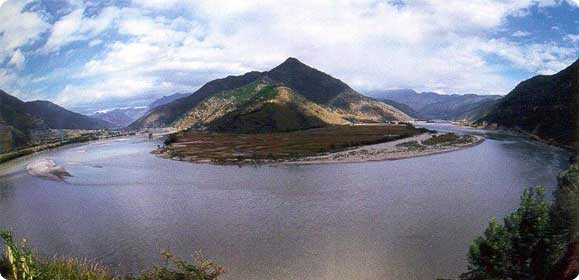Yangtze River First Bend
长江第一湾

The First Bend of the Yangtze lies in Shigu Town, Lijiang. Rushing down from the Qinghai-Tibet Plateau, "the roof of the world", the Yangtze surges into Yunnan from its northwest, where it meets Lancang River and Nu River. Then, they go together through the high mountains and deep gorges of Hengduan Mountains. Rushing southwards from the Qinghai-Tibet Plateau, the Yangtze is blocked by the Hailuo Cliff at Shigu, Yunnan, which makes it turn roughly to northeast, forming a rare great bay of "V" shape, which is called the First Bay of the Yangtze. According to the geologist, the Yngtze flowed southwards along Hengduan Mountains to Jianchuan and Yangbi Gorge in ancient time; later, land movement resulted in the change of the landform, which forced the river to divert, forming the turn of its flowing direction from south to east. Surrounded by water and mountains, the First Bay of the Yangtze has picturesque scenery, the river flowing slowly in the broad channel, a belt of willows growing along the bank, Yunling Mountains stretching around and enclosing it, tiers of terraced fields entwining the mountain slope, connecting with flat fields and farmhouses, which enjoys a reputation of "mini Jiangnan (south of the Yangtze)".
An ancestor composed this poem: "the surging river turns its direction here, then rushing magnificently into the middle land". There is a folk legend about the origin of the bay that: the three sisters, Nu Rive, Lancang River and Jinsha River, went to travel together. After a quarrel breaking out between them half way into their journey, the eldest two sisters went southwards obstinately; Jinsha River, however, determined to look for brightness and love in the east where the sun rises. So, when arriving at Shigu, she bid farewell to her sisters and turned to the east with fortitude. And the place where she turned around became the First Bay of the Yangtze. The river is broad at the Shigu Ferry, where the water flows slowly, which is suitable for ferrying across the river. So, it has always been a place of strategic importance in the history. It is said that during the Three States period, Zhuge Liang conquered the center of the south and crossed Lu (Jinsha River in ancient time) in May; in the year 1253 AD, Hubilie also crossed the river from Gennang; in Apr, 1936, led by Helong, Chinese Workers and Peasants' Red Army crossed the river and went northwards to fight against the Japanese army. After liberation, at the slope behind the Shigu Monument, people established the Monument to Red Army's Ferrying in the Long March of 8.1 m high. Standing on the high slope, magnificent and solemn, it is the historical and cultural relics under state protection in Yunnan Province. The building standing before the monument is the Memorial Room of Red Army's Ferrying. The relics displayed in the exhibition room can give you a vivid picture of this great army half a century ago.
At the mountain besides the First Bend of the Yangtze, stands a small town which is named Shigu Town. That is because, in the town, there is a monument carved in the white marble in the shape of a drum, whose diameter is 15 m and thickness is 0.7 m. It is for memorizing the victory of the outspread of power of Baizhuang, the Tusi of Mu Family of Lijiang, during Jiajin years in the Ming Dynasty. Until now, it is one of the stone monuments built in the earliest period in Lijiang. On its right, there is a willow forest at the bank; on the left, the Chongjiang River flows. Across the river, there is the Tiehong Bridge of 17 m, boards paving on iron chains with iron chains as its fence on both sides. As an important town on the trade route for tea and horses between the inland and Tibet. Shigu Town has flourishing fair trade, which is very busy and held every three days.
Tiger Leaping Gorge
About 100 kilometers (62 miles) northwest of Lijiang Old Town lying between Jade Dragon Snow Mountain (Yulong Xueshan) and Haba Snow Mountain (Haba Xueshan) is Tiger Leaping Gorge (Hutiao Gorge), which is believed to be the deepest gorge in the world. From the top of the gorge you look down the steeply angled (70-90 degrees) mountain sides to the rushing Golden Sands (Jingsha) River with its 18 frothing rapids more than 200 meters (about 700 feet) below.
Naturally divided into three sections, the first section, which is the narrowest and uppermost section, is the mouth of the fast flowing Jingsha River. In the midst of the river's mouth is a large rock that is positioned at the gorge's narrowest section-only 30 meters (33 yards) wide. An ancient legend says that a tiger used this rock as its stepping stone so it could leap across from one side of the gorge to the other, which is how the gorge got its name.
As the river enters the middle section, it drops another 100 meters (330 feet) and its flow rate increases to an amazing speed. Here the thunderous rushing waters slam into sharp, large rocks and crash down into the river forming swirling whirlpools. Can it get more exciting? Yes, it can as the third and lowest section is acclaimed for being the wildest attraction of all!
The cliffs over-looking this section are even steeper and much more dangerous. Here, the river twists and turns and the river vigorously surges forward creating high waves and a frothy spew as it collides with the mountainsides. This is a view that inspires a sense of adventure and satisfies the deepest yearnings for magnificent scenery.
|



